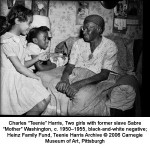(”C.Denise Johnson is a freelance writer based in Pittsburgh PA. Contact her at cdenisejohnson@gmail.com. This article is © Soul Pitt Media and was first published in www.TheSoulPitt.com ”Pittsburgh’s Premier Minority Community Website.” All rights reserved. Reprinted by permission. Visit us on the web at: www.thesoulpitt.com“)
Sometimes it’s hard to appreciate greatness when you see it every day. Those snippets of nirvana can become routine and taken for granted when it surrounds you all the time and it’s only after that daily aesthetic is gone that in hindsight you realize what you’ve missed. Such is the case with Black Pittsburgh.
Excellence and greatness was part of the mid-20th century with the two best Negro League baseball teams, Jazz luminaries, the National Negro Opera Company and likes of artists Romare Bearden and Jacob Lawrence all emanating from this singular speck of southwest Pennsylvania. It was all captured through the lens of Charles “Teenie” Harris’ camera and frequently ended up on the pages of the Pittsburgh Courier.
Although many knew of his skills as a photographer, few were aware of the significance that his work would come to symbolize. Harris was so efficient and proficient in his craft that Pittsburgh Mayor David Lawrence dubbed him “One Shot.” In the course of his 40-plus year career as a photojournalist, Harris amassed more than 80,000 images. Although not a nationally-known photographer like James van der Zee (best-associated with the Harlem renaissance), Life magazine photographer Gordon Parks or Pulitzer Prize-winning Ebony magazine photographer Moneta Sleet, “Teenie” Harris’ work is arguably the largest comprehensive photographic documentation of a minority community in the United States. The late Clarence Rolla Turner, a sociologist and historian of Black history, said Harris’ work constitutes “one of the most complete chronologies of a black community in the United States.”
Domestics, porters, teamsters, mill workers and their children are as present in these images as American presidents and other national celebrities. Moreover, despite the deeply sympathetic and often up-beat nature of the images, the viewer is still struck by the aura of racism and segregation that framed and inevitably marked the lives of Pittsburgh’s Black citizens.
Pictures do not lie and Harris did his work the old-fashioned way, before the computer-aided photography. His images documented the way we were. Segregated, relegated, denigrated by a Jim Crow America, yet Black folks were a hard-working, earnest and dignified lot who took pride in their communities, their appearance and their deportment. While mainstream media may have cast Negros as second-class citizens, Harris’ images told the story of dapper men who were “clean as a bean” and impeccably dressed women who conducted themselves with class in their everyday lives.
The fruit of countless hours of documentation and research over ten years is finally ready for a close-up examination as the Carnegie Museum of Art offers an extensive retrospective of Harris’ work. “Teenie Harris, Photographer: An American Story” is much more that a gallery showing of his pictures, it is a multimedia happening.
After passing through an obligatory introductory display, you enter a large, wide-open space with a scattering of benches to sit on as you as transported back in time by the seven large projected images on the wall and the original music recorded by the Manchester Craftsman’s Guild. You could easily spend a few hours in this first space alone to fully absorb the magnificence of photographic detail of each picture. Photos of men drinking in bars and children crowding around a summer swimming pool appear alongside scenes of civil rights protests and union-backed demonstrations.
An adjoining space houses 16 computers and 987 mounted and matted images hanging amid relaxing couches, A third gallery space contains a dozen photo favorites selected by experts of the exhibit committee, oral histories offered to enhance your perusal on MP3 players and the short “Artist at Work” film.
The archive project is as much as a labor of love as it is historical document. For some who worked on the project it was personal.
“I gave my own oral history recording and volunteered for four years bringing many others to share their stories of Teenie and what was occurring in the photos he took of them,” said Charlene Foggie Barnett, who is featured as a toddler in the exhibit. “I was particularly struck by the fact that the collection was not of cropped versions, but the unbelievably discerning raw negatives. At the beginning of 2011, I was hired to conduct and record close to 100 oral history interviews for the collection and to work in the gallery with the nearly 1,000 photos selected for this particular exhibit.”
“Teenie photographed me from my month-old baptismal photo through my young adult years,” recalls Barnett. “And each time it was always the same scenario: he would arrive in a flurry of motion, and then would survey the design of the shot, all the while his hands moving glass plates in and out of his large Speed Graphic camera. Routinely he’d bend to one knee and adjust my clothing or hair, and remind me he was only going to take “one shot”, so I was to stay still and look at the camera. He’d take the picture, pop the large flashbulb out of the camera and catch it in his pocket or behind his back, blow on it to cool its still glowing filament, and hand me the bulb as a treasured souvenir of the moment. I felt that Teenie was my personal friend, as he never spoke down to me nor as a child, and I looked forward to seeing him whether it be at a social event, or if he dropped by our home to deliver pictures to my parents (Bishop and Mrs. Charles Foggie), or at the YMCA, at our church (Wesley Center A.M.E. Zion) or at the Courier.”
If you can’t get enough of Teenie Harris, Photographer: An American Story, before the exhibition concludes its run on April 7, 2012, (it travels to Chicago, Atlanta and Birmingham, Alabama) you can take some of the show home with you. Teenie Harris, Photographer: Image, Memory, History, a fully illustrated book dedicated to the life and work of photographer Charles “Teenie” Harris is available for purchase. The 208-page book, which features a preface by Deborah Willis and significant essays by scholars Cheryl Finley, Laurence Glasco and Joe Trotter, analyzes Harris as an artist. It explores the social and historical context of his photographs and provides a detailed biography of the photographer whose archive of nearly 80,000 images is considered one of the most important documentations of 20th-century African American life. It includes 100 plates of Harris’ signature images and will be available for $24.95 in softcover and $55 in hardcover.



